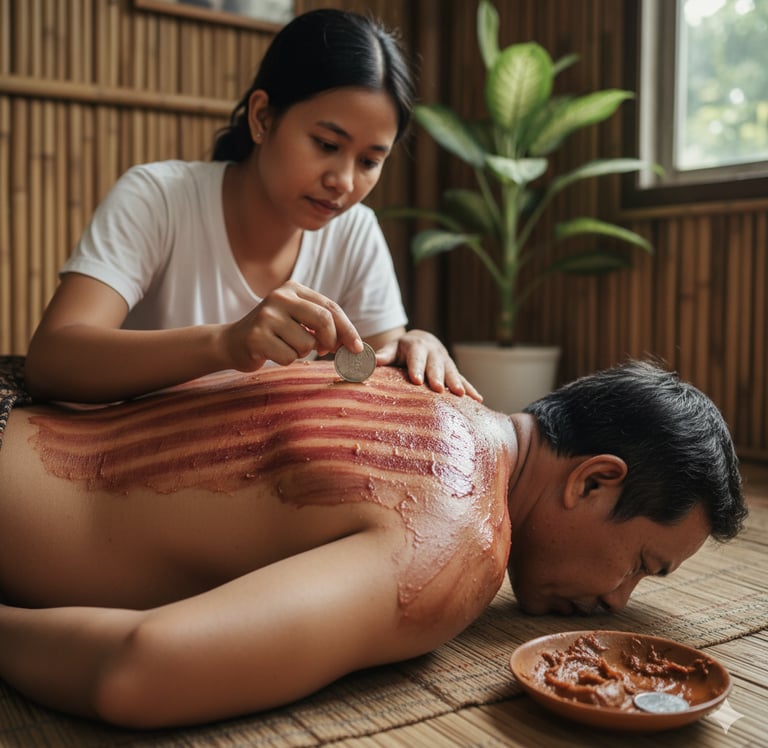Kerokan (Indonesian Scraping Massage)
Call-in-Services


Kerokan (Indonesian Scraping Massage)
Kerokan, also known as Gua Sha (in Traditional Chinese Medicine) or "coining," is a traditional Indonesian and Southeast Asian folk remedy. While technically a form of scraping therapy rather than a massage technique, it is often performed by massage therapists or family members to treat symptoms related to illness and fatigue.
1. Core Philosophy and Purpose
The practice of Kerokan is deeply rooted in the Indonesian belief in treating "Masuk Angin" (literally: "entry of wind"). This is a cultural diagnosis referring to a state of feeling unwell, often characterized by chills, fever, headache, body aches, fatigue, and nausea—symptoms similar to the common cold or flu.
Aspect & Description
Goal of the Treatment To draw out the "bad wind" or cold air believed to be trapped beneath the skin. The therapy aims to restore balance and warmth to the body.
Therapist/Practitioner Often performed by trained traditional massage therapists, but frequently done by family members at home, making it a deep-seated cultural remedy.
Area of Focus Primarily the upper back, neck, and sometimes the chest and ribs.
2. Technique and Tools
The technique is visually distinct and relies on friction to create petechiae (small, localized broken capillaries) on the skin's surface.
Tool: A blunt-edged object, most commonly a coin (rupiah), but also sometimes ginger, a piece of horn, or a smooth stone.
Lubricant: A massage oil or, more traditionally, a medicated balm or oil containing ginger, eucalyptus, or citronella (such as Minyak Kayu Putih or Balsem). This enhances warmth and reduces superficial friction.
Action: The therapist firmly and repeatedly scrapes the edge of the coin or tool along the skin in linear, unidirectional strokes, usually moving from the spine outward along the ribs or muscle groups.
3. The Signature Mark: Appearance and Interpretation
The most noticeable result of Kerokan is the appearance of distinct, red to dark-purple stripes on the treated area.
The Marks: These marks are intentional and are caused by the microtrauma of the scraping action, which ruptures minute blood vessels (capillaries) beneath the skin.
Interpretation of Color: In traditional Indonesian belief, the darker the stripe, the more Masuk Angin (trapped "wind" or illness) the person has. Lighter or faint marks indicate less severe symptoms or a body already improving.
Healing Time: The marks are typically visible for 3 to 7 days, similar to deep bruising, and should not be painful once the treatment is finished.
4. Scientific Perspective and Benefits
While rooted in tradition, modern studies suggest potential physiological mechanisms for Kerokan's effectiveness:
Increased Microcirculation: The scraping action drastically increases blood flow and capillary circulation to the treated area, which helps carry away metabolic waste and reduces inflammation.
Pain Modulation: The controlled application of friction can activate the body’s natural analgesic response, offering immediate relief from muscle aches.
Immune Response: The localized microtrauma triggers an anti-inflammatory and immune response in the body, potentially helping the body fight off the underlying illness.
In summary, Kerokan is a powerful, intensive folk therapy primarily used to treat the symptoms of Masuk Angin. It is a unique cultural experience that provides both immediate muscle relief and a visible indicator of therapeutic action.


💵Services Price List :
90 Minutes Treatment = Rp 350.000
Contact
Reach us anytime for your SPA and Massage treatment needs
Phone
©Bliss Home Spa 2025. All rights reserved.
